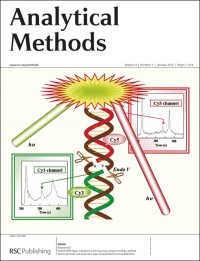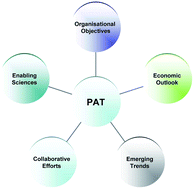Issue 3 of Analytical Methods is now available for you to browse.
We take you to Germany and Brazil on this month’s covers: transport across cell monolayers studied by SECM, and the determination of mercury in soil by CVG-ICP-MS.
Issue 3 of Analytical Methods is now available for you to browse.
We take you to Germany and Brazil on this month’s covers: transport across cell monolayers studied by SECM, and the determination of mercury in soil by CVG-ICP-MS.
Take a look at the latest issue of Analytical Methods, now available online.
The stunning front cover highlights work from James Cizdziel of the University of Mississippi, and colleagues.
They evaluate the use of multiple botanical reference materials as LA-ICP-MS standards for quantifying the spatial distribution of elements in desert leaves.
Determination of elements in situ in green leaves by laser ablation ICP-MS using pressed reference materials for calibration
James Cizdziel, Kaixuan Bu and Piotr Nowinski
Anal. Methods, 2012, 4, 564-569
DOI: 10.1039/C1AY05577A
The inside front cover features a sensitive and selective analytical method utilising LC-ESI-MS/MS for the semi-quantitative determination of biogenic amines and amino acids in porcine decomposition fluid.
This paper is from Simon Lewis and colleagues from Curtin University, Perth, Australia, and was highlighted as a HOT article when it first appeared online.
Determination of amino acids and amines in mammalian decomposition fluid by direct injection liquid chromatography-electrospray ionisation-tandem mass spectrometry
Lisa M. Swann, Francesco Busetti and Simon W. Lewis
Anal. Methods, 2012, 4, 363-370
DOI: 10.1039/C1AY05447C
Both articles will be free to access for 6 weeks.
Happy New Year! Our first issue of 2012 is now online for you to read.
On the front cover is work from Daniel Attinger of Columbia University, New York, USA and his colleagues from other US institutions.
Their study proposes that images of stains from 100-nanolitre drops can be automatically identified as signatures of fluid composition and substrate chemistry, which has implications for areas such as biological testing.
They used classification algorithms to identify unknown stains, and demonstrated a high level of accuracy.
Identification of fluid and substrate chemistry based on automatic pattern recognition of stains
Namwon Kim, Zhenguo Li, Cedric Hurth, Frederic Zenhausern, Shih-Fu Chang and Daniel Attinger
Anal. Methods, 2012, 4, 50-57
DOI: 10.1039/C1AY05338H
On the inside front cover, Akira Kotani of the Tokyo University of Pharmacy and Life Sciences, Japan, performed alongside international collaborators from the USA and Korea.
 They report the ability to detect sporadic mutations with high sensitivity using a mutation scanning assay, which employs thermostable endonuclease V (EndoV) and DNA ligase.
They report the ability to detect sporadic mutations with high sensitivity using a mutation scanning assay, which employs thermostable endonuclease V (EndoV) and DNA ligase.
Their microchip method is shown to be considerably faster than conventional capillary gel electrophoresis.
EndoV/DNA ligase mutation scanning assay using microchip capillary electrophoresis and dual-color laser-induced fluorescence detection
Akira Kotani, Małgorzata A. Witek, John K. Osiri, Hong Wang, Rondedrick Sinville, Hanna Pincas, Francis Barany and Steven A. Soper
Anal. Methods, 2012, 4, 58-64
DOI: 10.1039/C1AY05366C
Both these articles will be free to access for 6 weeks: enjoy!
The final issue of Analytical Methods for 2011 is now online.
The front cover features a Critical Review on one-step manufacturing processes for the prototyping of microfluidic devices from Bastian Rapp of Karlsruhe Institute of Technology, Germany, and colleagues.
Critical Review: Let there be chip – towards rapid prototyping of microfluidic devices: one-step manufacturing processes
Ansgar Waldbaur, Holger Rapp, Kerstin Länge and Bastian E. Rapp
Anal. Methods, 2011, 3, 2681-2716
DOI: 10.1039/C1AY05253E
On the back cover is work from Carlos Ubide and co-workers at Universidad del País Vasco, Spain who look at process analytical chemistry in a nickel electroplating baths.
Process analytical chemistry in a nickel electroplating bath. Automated sequential injection for additive determination
M. Ostra, C. Ubide, M. Vidal and J. Zuriarrain
Anal. Methods, 2011, 3, 2726-2732
DOI: 10.1039/C1AY05434A
Thank you to all our cover authors this year, and we look forward to bringing you more exciting science (and excellent images!) in 2012.
On the cover of the latest issue of Analytical Methods is a minireview from Kate Griffiths and colleagues at the Australian National Measurement Institute.
When using quantitative PCR, a calibration curve is commonly constructed from serial dilution of a reference DNA preparation and the test material is quantified by comparison to the curve. There are many factors in this process that can affect the accuracy of the measured value, and there have been some efforts to standardise or optimise this technique as there is ample evidence of measurement inconsistencies.
Here, Griffiths et al. present a relatively simple process for estimating measurement uncertainty for quantitative DNA measurements produced by qPCR, with a worked example.
Quantitative polymerase chain reaction: a framework for improving the quality of results and estimating uncertainty of measurement
Kate R. Griffiths, Daniel G. Burke and Kerry R. Emslie
Anal. Methods, 2011, 3, 2201-2211
DOI: 10.1039/C1AY05069A
This article will be free for 6 weeks.

Critical Review: Trends in process analytical technology
Wee Chew and Paul Sharratt
Anal. Methods, 2010, 2, 1412-1438
DOI: 10.1039/C0AY00257G
In the latest issue of Analytical Methods, three articles are highlighted on the covers.
On the front cover is work from Robin Taylor and colleagues of the National Nuclear Laboratory, at various sites across the UK.
There are a number of nuclear legacy fuel storage ponds and silos in the UK that contain substantial volumes of corroding spent Magnox fuel pieces. Understanding the nature and behaviour of the radionuclides in the ponds, including any potential for activity transfer from solid to solution phases, is critical in the environmental clean-up of these nuclear legacy facilities. The results presented in this paper indicate that Pu redox chemistry, and therefore solubility, varies across the pond, which has implications for Pu behaviour during waste processing.
Characterisation of plutonium species in alkaline liquors sampled from a UK legacy nuclear fuel storage pond
Colin R. Gregson, Jeremy J. Hastings, Howard E. Sims, Helen M. Steele and Robin J. Taylor
Anal. Methods, 2011, 3, 1957-1968
DOI: 10.1039/C1AY05313B
Work from Toshihiro Fujii of Meisei University and colleagues is shown on the inside front cover.
They investigated the thermal decomposition of Japanese lacquer liquid and films by means of evolved gas analysis-ion attachment mass spectrometry. Their results indicated two stages of water release, vaporization and intramolecular H2O elimination, and the kinetics of these two processes were studied.
Characterization of Japanese lacquer liquid and films by means of evolved gas analysis-ion attachment mass spectrometry
Masamichi Tsukagoshi, Yuki Kitahara, Seiji Takahashi, Takahisa Tsugoshi and Toshihiro Fujii
Anal. Methods, 2011, 3, 1943-1947
DOI: 10.1039/C1AY05215B
On the back cover, Sherif A. El-Safty and Nguyen Duc Hoa of the National Institute for Materials Science introduce the use of highly ordered mesoporous silica/metal oxide nanocomposite monoliths for volatile organic compound gas sensor applications.
Highly sensitive and selective volatile organic compound gas sensors based on mesoporous nanocomposite monoliths
Nguyen Duc Hoa and Sherif A. El-Safty
Anal. Methods, 2011, 3, 1948-1956
DOI: 10.1039/C1AY05333G
Did you catch the happy cover for Issue 8?
The rather smiley picture on the front cover highlights a review by Sangeeta Tanna and Graham Lawson of De Montfort University on the analytical methods used in conjunction with dried blood spots. Access this article for free using the link below:
Critical Review: Analytical methods used in conjunction with dried blood spots
Sangeeta Tanna and Graham Lawson
Anal. Methods, 2011, 3, 1709-1718
DOI: 10.1039/C1AY05160
The back cover features work from Amina Woods of the National Institute on Drug Abuse, NIH on the use of MALDI-MS lipid imaging in rat brain tissue.
Communication: Highlighting anatomical sub-structures in rat brain tissue using lipid imaging
Alice M. Delvolve, Benoit Colsch and Amina S. Woods
Anal. Methods, 2011, 3, 1729-1736
DOI: 10.1039/C1AY05107E
Yan Jin and colleagues propose an electrochemical method for the selection of natural G-quadruplex-binding ligands in their communication featured on the front cover.
Electrochemical selection of G-quadruplex-binding ligands based on structure-switching of telomeric DNA
Xiao-Qin Liu, Yan Jin, Yuexia Wang and Yunxia Qiao
Anal. Methods, 2011, 3, 1270-1273
DOI: 10.1039/C1AY05046J
This communication will be free until the 21st July.
HOT papers in this issue include:
A novel method for the determination of individual lanthanides using an inexpensive conductometric technique
Komal Matharu, Susheel K. Mittal and S. K. Ashok Kumar
Anal. Methods, 2011, 3, 1290-1295
DOI: 10.1039/C0AY00747A
A Phos-tag-based fluorescence resonance energy transfer system for the analysis of the kinase reaction of a substrate peptide
Masao Somura, Kei Takiyama, Emiko Kinoshita-Kikuta, Eiji Kinoshita and Tohru Koike
Anal. Methods, 2011, 3, 1303-1309
DOI: 10.1039/C1AY05016H
Why not take a look at the articles today and blog your comments below.
In the latest issue, the front cover highlights an article by Mary Kate Donais and colleagues. They analysed over 80 fresco samples at the Coriglia Castel Viscardo excavation site near Orvieto, Italy to evaluate data processing and analysis approaches using portable X-ray fluorescence spectrometry and portable Raman spectroscopy.
Evaluation of data processing and analysis approaches for fresco pigment studies by portable X-ray fluorescence spectrometry and portable Raman spectroscopy
Mary Kate Donais, David George, Bradley Duncan, Sara M. Wojtas and A. M. Daigle
Anal. Methods, 2011, 3, 1061-1071
DOI: 10.1039/C0AY00736F
On the inside cover is a Communication from Yang and Xu which presents a colorimetric method based on an organic Fenton reaction for the easy detection of glucose.
Communication: Facile colorimetric detection of glucose based on an organic Fenton reaction
Xiaowen Xu and Xiurong Yang
Anal. Methods, 2011, 3, 1056-1059
DOI: 10.1039/C1AY05042G
Both these articles are free to access until 21 June, so do take a look.
Issue 4 of 2011 is now available online.
On the front cover: José M. Pingarrón and colleagues from the Complutense University of Madrid use of DNA electrochemical sensors combined with PCR-amplification strategies for the detection of microorganisms.
Critical Review: Electrochemical genosensors based on PCR strategies for microorganisms detection and quantification
María Pedrero, Susana Campuzano and José M. Pingarrón
Anal. Methods, 2011, 3, 780-789
DOI: 10.1039/C0AY00755B
On the inside front cover: Eithne Dempsey and co-workers from Institute of Technology Tallaght, Dublin report a novel immunosensor platform technology based on self-assembled monolayer (SAM) of electrodeposited gold (Au) nanostructures with subsequent antibody attachment.
Evaluation of a modified carbon micromesh electrode as a new substrate for electrochemical immunosensing
Dhanraj Rathod, Susan Warren, Kevin Keane, Denise A. Egan and Eithne Dempsey
Anal. Methods, 2011, 3, 799-805
DOI: 10.1039/C0AY00665C
Both these articles are free to access for six weeks, so do take a look.